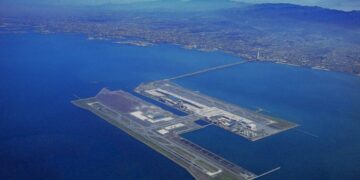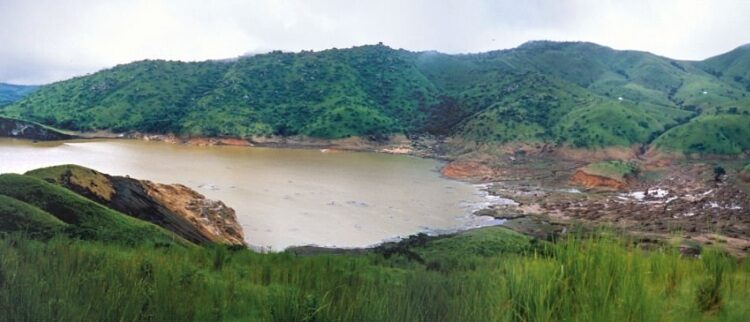Prepare-se para uma das histórias de desastres naturais mais bizarras e aterrorizantes já registradas. Imagine adormecer pacificamente em sua aldeia e nunca mais acordar, não por causa de um terremoto, vulcão ou inundação, mas porque o lago próximo decidiu… explodir em uma nuvem de gás invisível e mortal. Isso não é ficção científica; aconteceu de verdade no Lago Nyos, nos Camarões.
A Noite Silenciosa e Mortal: 21 de Agosto de 1986
Na noite de 21 de agosto de 1986, algo terrivelmente errado aconteceu no Lago Nyos, um lago formado na cratera de um vulcão adormecido no noroeste dos Camarões. Por volta das 21h, sem qualquer aviso sonoro ou tremor significativo, o lago liberou uma quantidade colossal de dióxido de carbono (CO2) que estava silenciosamente dissolvido em suas profundezas. As estimativas variam, mas falam em algo entre 100.000 e espantosos 1,6 milhão de toneladas de gás!
Esse CO2, sendo cerca de 1,5 vezes mais denso que o ar, não se dissipou para o céu. Em vez disso, formou uma nuvem invisível e sufocante, com talvez 50 metros de espessura, que desceu pelas encostas como um cobertor mortal. A nuvem viajou a velocidades estimadas entre 20 e incríveis 100 km/h, invadindo vales e vilarejos próximos.
Um Cenário de Pesadelo: O Despertar Macabro
Em questão de minutos, o ar em um raio de até 25 quilômetros ao redor do lago tornou-se irrespirável. Nas aldeias de Nyos, Kam, Cha e Subum, a morte chegou silenciosamente enquanto as pessoas dormiam. O CO2 simplesmente deslocou o oxigênio, asfixiando suas vítimas sem deixar rastros de violência. Estima-se que 1.746 pessoas e cerca de 3.500 cabeças de gado morreram naquela noite.
Os poucos sobreviventes acordaram para um cenário de horror absoluto. Não havia destruição, apenas silêncio e morte. Cadáveres estavam por toda parte, alguns com sangue escorrendo pelo nariz e boca. Até mesmo os insetos, como as moscas, caíram mortos. Repórteres que chegaram ao local descreveram a cena como “o rescaldo de uma bomba de nêutrons”, onde as estruturas permanecem, mas a vida desaparece.
Joseph Nkwain, um sobrevivente de Subum, relatou sua experiência angustiante: “Eu não conseguia falar. Fiquei inconsciente… ouvi minha filha roncando de uma forma terrível, muito anormal… Ao atravessar para a cama dela… desmaiei e caí… só acordei às nove da manhã… Fiquei surpreso ao ver que minhas calças estavam vermelhas… meus braços tinham algumas feridas… Eu queria falar, mas minha respiração não saía… Minha filha já estava morta… Fui às casas dos meus vizinhos. Estavam todos mortos.” Muitos dos cerca de 4.000 habitantes que fugiram desenvolveram problemas respiratórios, lesões de pele (causadas pela pressão e falta de oxigênio, não queimaduras químicas) e até paralisia.
O Mistério da Erupção Límnica: O Que Diabos Aconteceu?
Este evento bizarro é chamado de “erupção límnica”, um fenômeno incrivelmente raro – de fato, só existem dois casos registrados na história! O outro ocorreu apenas dois anos antes, em 1984, no Lago Monoun, também nos Camarões, matando 37 pessoas.
Mas o que causa isso? O Lago Nyos fica sobre uma área vulcânica. Gases, principalmente CO2, emanam do magma abaixo e se dissolvem na água fria e profunda do lago, acumulando-se em concentrações altíssimas sob enorme pressão. A água mais quente e menos densa na superfície normalmente atua como uma “tampa”, mantendo o gás aprisionado.
Naquela noite fatídica, algo rompeu essa “tampa”. O gatilho exato permanece um mistério até hoje, o que torna o evento ainda mais assustador. As teorias incluem:
- Deslizamento de terra: Rochas ou terra caindo no lago poderiam ter perturbado as camadas de água.
- Pequena erupção vulcânica: Uma pequena liberação de lava ou gás no fundo do lago.
- Inversão por chuva: Chuva fria e pesada caindo em um lado do lago poderia ter resfriado a superfície e causado uma mistura abrupta das camadas.
- Terremoto: Embora nenhum tremor tenha sido relatado pelos sobreviventes, não pode ser totalmente descartado.
Qualquer que tenha sido o gatilho, ele causou uma mistura rápida da água profunda supersaturada com a água superficial. Com a diminuição súbita da pressão, o CO2 dissolvido saiu violentamente da solução, como abrir uma garrafa de champanhe gigante e super agitada.
Cientistas estimam que a liberação foi tão violenta que formou uma coluna de água e espuma de 100 metros de altura na superfície, gerando uma onda (tsunami) de até 25 metros que varreu uma das margens, derrubando árvores. Após a erupção, a água do lago, normalmente azul, ficou vermelho-escura devido ao ferro das profundezas que subiu e oxidou em contato com o ar. O nível do lago baixou cerca de um metro.
Conspirações e Soluções: Tentando Evitar o Próximo Apocalipse Aquático
A natureza bizarra e sem precedentes do desastre alimentou teorias da conspiração, com alguns locais alegando que testes secretos de bombas pelos governos de Israel e Camarões causaram a explosão – algo que não se encaixa na cronologia ou nas evidências científicas.
Para evitar que essa tragédia se repetisse, cientistas e engenheiros desenvolveram uma solução engenhosa: instalar tubos verticais no lago. Esses tubos funcionam como canudos gigantes, bombeando inicialmente a água rica em CO2 do fundo para a superfície. Uma vez iniciado o fluxo, o próprio gás que sai da solução na tubulação torna o processo autossustentável, liberando o CO2 lentamente e de forma controlada na atmosfera. O primeiro tubo foi instalado em 2001, seguido por mais dois em 2011. Em 2019, concluiu-se que apenas um tubo seria suficiente para manter os níveis de CO2 seguros indefinidamente.
O Perigo Espreita em Outros Lagos?
A tragédia de Nyos levantou preocupações sobre outros lagos vulcânicos profundos. O Lago Kivu, na fronteira entre a República Democrática do Congo e Ruanda, é 2.000 vezes maior que Nyos e também contém enormes quantidades de CO2 dissolvido (e metano!). Estudos iniciais sugeriram um risco iminente, mas pesquisas mais recentes (2020) indicam que, embora o perigo exista, ele pode não estar aumentando tão rapidamente quanto se pensava.
Enquanto isso, no próprio Lago Nyos, surgiu outra preocupação: a parede natural da cratera que contém o lago estava enfraquecendo. Um colapso poderia liberar a água (e potencialmente mais gás) de forma catastrófica. Uma barragem foi construída para reforçar a parede, mas o monitoramento continua.
O desastre do Lago Nyos permanece como um lembrete sombrio e bizarro das forças inesperadas e mortais que podem se esconder sob superfícies aparentemente tranquilas. Um lago que explode silenciosamente para matar milhares – uma história real que supera a ficção mais estranha.
The Killer Lake: Deadly Gas Exploded and Killed Thousands
Discover the story of one of the strangest and most silent natural disasters recorded.
Brace yourself for one of the most bizarre and terrifying natural disaster stories ever recorded. Imagine falling peacefully asleep in your village and never waking up, not because of an earthquake, volcano, or flood, but because the nearby lake decided… to explode in an invisible, deadly cloud of gas. This isn’t science fiction; it really happened at Lake Nyos in Cameroon.
The Silent, Deadly Night: August 21, 1986
On the night of August 21, 1986, something went terribly wrong at Lake Nyos, a lake formed in the crater of a dormant volcano in northwestern Cameroon. Around 9 PM, without any significant sound or tremor, the lake released a colossal amount of carbon dioxide (CO2) that had been silently dissolving in its depths. Estimates vary, but they range from 100,000 to a staggering 1.6 million tons of gas!
This CO2, being about 1.5 times denser than air, didn’t dissipate into the sky. Instead, it formed an invisible, suffocating cloud, perhaps 50 meters (about 160 feet) thick, that descended the slopes like a deadly blanket. The cloud traveled at estimated speeds between 20 and an incredible 100 km/h (12 to 62 mph), invading nearby valleys and villages.
A Nightmare Scenario: The Macabre Awakening
Within minutes, the air in a radius of up to 25 kilometers (about 16 miles) around the lake became unbreathable. In the villages of Nyos, Kam, Cha, and Subum, death arrived silently while people slept. The CO2 simply displaced the oxygen, asphyxiating its victims without leaving traces of violence. An estimated 1,746 people and about 3,500 head of livestock died that night.
The few survivors woke up to a scene of absolute horror. There was no destruction, just silence and death. Corpses were everywhere, some with blood running from their noses and mouths. Even insects, like flies, had dropped dead. Reporters who arrived on the scene described it as “the aftermath of a neutron bomb,” where structures remain, but life disappears.
Joseph Nkwain, a survivor from Subum, recounted his harrowing experience: “I could not speak. I became unconscious… I heard my daughter snoring in a terrible way, very abnormal… When crossing to my daughter’s bed… I collapsed and fell… I only woke up at nine o’clock in the morning… I was surprised to see that my trousers were red… my arms had some wounds… I wanted to speak, but my breath would not come out… My daughter was already dead… I went to my neighbours’ houses. They were all dead.” Many of the roughly 4,000 inhabitants who fled developed respiratory problems, skin lesions (caused by pressure and lack of oxygen, not chemical burns), and even paralysis.
The Mystery of the Limnic Eruption: What on Earth Happened?
This bizarre event is called a “limnic eruption,” an incredibly rare phenomenon – in fact, there are only two recorded cases in history! The other occurred just two years earlier, in 1984, at Lake Monoun, also in Cameroon, killing 37 people.
But what causes it? Lake Nyos sits over a volcanic area. Gases, mainly CO2, emanate from the magma below and dissolve into the cold, deep lake water, accumulating in extremely high concentrations under immense pressure. The warmer, less dense water at the surface normally acts as a “cap,” keeping the gas trapped.
On that fateful night, something broke this “cap.” The exact trigger remains a mystery to this day, making the event even more frightening. Theories include:
- Landslide: Rocks or soil falling into the lake could have disturbed the water layers.
- Small volcanic eruption: A minor release of lava or gas at the bottom of the lake.
- Rainfall-induced turnover: Heavy, cold rain falling on one side of the lake could have cooled the surface and caused an abrupt mixing of layers.
- Earthquake: Although no tremors were reported by survivors, it cannot be completely ruled out.
Whatever the trigger, it caused a rapid mixing of the supersaturated deep water with the surface water. With the sudden drop in pressure, the dissolved CO2 violently came out of solution, like opening a giant, super-shaken bottle of champagne.
Scientists estimate the release was so violent it formed a column of water and foam 100 meters (about 330 feet) high on the surface, generating a wave (tsunami) up to 25 meters (about 82 feet) high that swept one of the shores, knocking down trees. After the eruption, the lake’s normally blue water turned a deep red due to iron from the depths rising and oxidizing upon contact with the air. The lake level dropped by about one meter (about 3 feet).
Conspiracies and Solutions: Trying to Prevent the Next Aquatic Apocalypse
The bizarre and unprecedented nature of the disaster fueled conspiracy theories, with some locals claiming that secret bomb tests by the Israeli and Cameroonian governments caused the explosion – something that doesn’t fit the timeline or scientific evidence.
To prevent this tragedy from happening again, scientists and engineers developed an ingenious solution: installing vertical pipes in the lake. These pipes act like giant straws, initially pumping the CO2-rich water from the bottom to the surface. Once the flow starts, the gas coming out of solution within the pipe makes the process self-sustaining, releasing the CO2 slowly and controllably into the atmosphere. The first pipe was installed in 2001, followed by two more in 2011. By 2019, it was concluded that a single pipe would be sufficient to keep CO2 levels safe indefinitely.
Does Danger Lurk in Other Lakes?
The Nyos tragedy raised concerns about other deep, volcanic lakes. Lake Kivu, on the border between the Democratic Republic of Congo and Rwanda, is 2,000 times larger than Nyos and also contains huge amounts of dissolved CO2 (and methane!). Initial studies suggested an imminent risk, but more recent research (2020) indicates that while the danger exists, it might not be increasing as rapidly as previously thought.
Meanwhile, at Lake Nyos itself, another concern arose: the natural crater wall containing the lake was weakening. A collapse could release the water (and potentially more gas) catastrophically. A dam has been built to reinforce the wall, but monitoring continues.
The Lake Nyos disaster remains a somber and bizarre reminder of the unexpected and deadly forces that can hide beneath apparently tranquil surfaces. A lake that silently explodes to kill thousands – a true story stranger than the weirdest fiction.

































